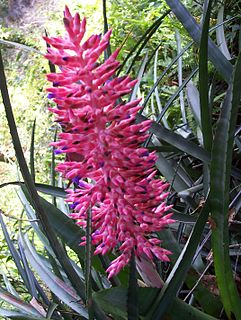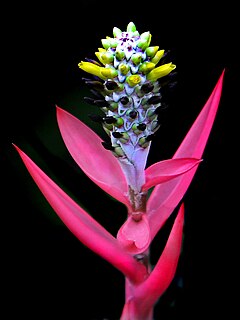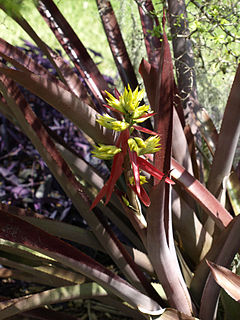
Aechmea bromeliifolia is a bromeliad native to southern Mexico, Central America, Trinidad, and South America as far south as northern Argentina.

Aechmea gamosepala is a bromeliad endemic to southern Brazil. It is often cultivated as an ornamental plant. This plant is cited in Flora Brasiliensis by Carl Friedrich Philipp von Martius

Aechmea nudicaulis is a bromeliad species in the genus Aechmea, which is often used as an ornamental plant. This species is native to Central America, the West Indies, central and southern Mexico, and northern and central South America.

Aechmea distichantha, the Brazilian vaseplant, or vase plant, is a bromeliad typical of Cerrado vegetation in Brazil, which is also native to northern Argentina, Bolivia, Paraguay, and Uruguay. This plant is often used as an ornamental plant.

Aechmea maculata is an evergreen plant species in the family Bromeliaceae and the genus Aechmea. It is endemic to the State of Minas Gerais in Brazil and is grown as an ornamental plant. It has yellow flowers and the ends of the bracts are sharply angled with a "v" shape.

Dyckia leptostachya is a plant species in the genus Dyckia. This species is native to Brazil, Bolivia, Paraguay, and Argentina.

Aechmea lamarchei is a plant species in the genus Aechmea. It is endemic to eastern Brazil, known only from the States of Minas Gerais and Espírito Santo.
Aechmea alba is a species of plant in the genus Aechmea. This species is endemic to Brazil.

Aechmea alopecurus is a plant species in the genus Aechmea. This species is endemic to Brazil, known only from the States of Bahia and Minas Gerais.
Aechmea bambusoides is a plant species in the genus Aechmea. This species is endemic to Brazil. It is native to the States of Minas Gerais and Rio de Janeiro. Mature fruits (berries) are pyriform, white and contain seeds spread in a fleshy transparent mucilage. Seeds are falcate-shaped, with a narrow micropylar portion, rough texture, brown-red colour and no appendages.
Aechmea bicolor is a plant species in the genus Aechmea. This species is endemic to the State of Santa Catarina in southern Brazil.
Aechmea burle-marxii is a plant species in the genus Aechmea. This species is endemic to Brazil, known from Bahia and Minas Gerais.

Aechmea emmerichiae is a species in the genus Aechmea. This species is endemic to Chapada Diamantina National Park in eastern Brazil.
Aechmea organensis is a plant species in the genus Aechmea. This species is endemic to southeastern Brazil.
Aechmea racinae, or Christmas jewels, is a species of flowering plant in the genus Aechmea, of the family Bromeliaceae. This species is endemic to the State of Espírito Santo in eastern Brazil. A. racinae grows best in partial sun and does not tolerate freezing temperatures.

Aechmea ramosa is a plant species in the genus Aechmea. This species is endemic to eastern Brazil.

Aechmea weilbachii is a plant species in the genus Aechmea. This species is endemic to eastern Brazil, known from the States of Espírito Santo and Rio de Janeiro.

Vriesea racinae is a plant species in the genus Vriesea. This species is an epiphyte endemic to Brazil. known from the States of Espírito Santo and Minas Gerais.

Tillandsia geminiflora is a species in the genus Tillandsia. This species is native to Brazil, Suriname, Paraguay, Uruguay, and the Misiones Province of Argentina.
Tillandsia polystachia is a species in the genus Tillandsia. This species is native to Central America, the West Indies, Bolivia, Colombia, Brazil, Ecuador, Mexico and Venezuela.













